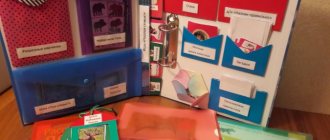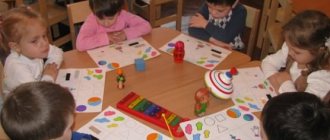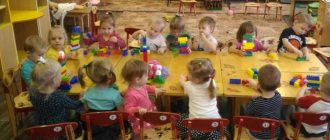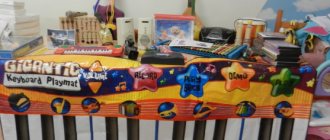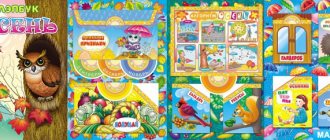Explain the method of introducing preschoolers to the work of adults in the junior and middle groups.
Children, especially younger and middle-aged children, are strongly influenced by the example of household labor of adults (cleaning, cooking, various actions of medical workers, laundresses, janitors, etc.). This work is understandable to children, since it is aimed at satisfying their personal needs, there are many interesting actions in it, and it can be observed often. It contains many points that are closely related to the behavior of the children themselves in maintaining cleanliness, order, and compliance with hygiene rules. Children's games show that they, on their own initiative, imitate the work of adults.
Junior group.
Observations of cleaning the kindergarten site. Observations of the work of adults in cleaning the site are organized with the entire group twice during the year, in winter and summer, during class hours. Children learn that adults maintain cleanliness and order in the kindergarten area and on the street, that the janitor uses a broom, a shovel, and has a hose to water the area.
In the summer, observations can be carried out either from the group window (the teacher places the children near the windows facing the garden or street) or on the site (not far from the cleaning site). The teacher invites the children to watch how the janitor cleans the garden, yard or street so that it is clean: he waters the paths and flowers. The teacher always emphasizes that the janitor has watered the paths and plants well, and it is good to play in a clean yard. During the walk, the teacher draws the children’s attention to ensure that they do not litter in the area, shows where to throw pieces of paper and other rubbish, and reminds them how the janitor worked to clean the area.
In winter, you can again watch the work of a janitor with your children; it is especially interesting to conduct such an activity after a snowfall. Children go for a walk along paths that have been cleared of snow in advance and see a janitor shoveling snow on the site. “How much snow fell today, all the paths were covered with snow? says the teacher. “The janitor is clearing them.” The teacher tells how the janitor shovels snow (with a wooden shovel), where he puts it (in a box placed on a sled), then takes it away on a sled from the site. Children can be asked to shovel snow and take it on a sled to an appointed place, so that later they can make a slide for dolls.
A tour of the kitchen. Kids enjoy watching the cook work. It is advisable that a day or two before the excursion, the cook visits the group, brings the children a baked pie or prepared fresh salad, asking them if they like this dish.
During the excursion to the kitchen, children are seated near the table on which minced meat for cutlets is prepared. The kids see how quickly the cook works, preparing cutlets, and watch how they cut vegetables for soup on another table. So that children can approach the table, it is better to see what the cook and his assistants are doing; all children are divided into two subgroups (12–13 children each).
Familiarization with the work of adults in the immediate environment. In addition to observing the work of adults in kindergarten, children in the younger group are introduced to the work of people in other professions. Kids are interested in how a driver drives a car, a tram driver drives a tram, and a train driver drives a train. You can talk on excursions about the work of the captain and sailors (in kindergartens in coastal cities or in cities located on the coasts of large rivers).
The ideas that young children receive about the work of adults create the prerequisites for the further development of the ability to see everything that is done by a person and to appreciate the work of adults.
Secondary children
Preschool children are introduced to those types of work of adults that can be directly observed, while the opportunity for practical participation in the work of children themselves expands.
A tour of the kitchen. During observation, children of the fifth year of life learn about the variety of labor processes involved in processing various products before the finished dish is served for lunch. The teacher pays attention to how adults work together and harmoniously. The cook shows the children equipment: an electric stove, an electric meat grinder, and devices for peeling and cutting vegetables.
For an excursion to the kitchen, the entire group of children is divided into two subgroups.
Familiarization with other types of household work for adults. Children of the fifth year of life are introduced to the process of washing clothes. During the conversation, the teacher finds out whether the children know how to wash clothes. Undoubtedly, in the family, every child could observe this work and even help the mother or grandmother in the work: for example, rinsing clothes in clean water, serving washed clothes for hanging after washing. Children readily talk about this when they come to kindergarten after a day off. It is important for the teacher that, from various impressions, the children develop correct ideas about this work, about all its processes. He talks about how the laundry is soaked first. Wash with soap or washing powder in warm water. White laundry is boiled on the stove in a special tank. Washing machines are used to wash clothes. There are special laundry factories where clothes are washed and ironed.
Children can be offered to wash doll clothes. This work can be done by 8-10 people: four wash, then the washed clothes are passed on to two other children, who rinse in the same water, two more rinse, wring out and give to hang. The next day or in the afternoon, when the linen is dry, iron it.
In classes in the middle group, children watch how clothes are sewn, how houses are built; how cows are grazed and cared for (this is possible in summer conditions, when the kindergarten goes to the country). During the observation, the teacher talks about the importance of these professions and the benefits that the work of these people brings to society.
During one of the classes, you can check whether the children have mastered the program material about the work of adults. An approximate topic of conversation in class is “Who does what.” During this conversation, the teacher finds out the children’s ideas about what people in the named professions do and what tools they need. The teacher asks first of all those children whose answer he doubts. The same conversation can be held about the driver of a car. The teacher asks the children: “Who drives the cars? Why do you need a driver's job? You should find out what cars the children know, what they drive, and who drives them. Question 30) reveal the method of introducing preschoolers to the work of adults in older groups of kindergarten
One of the main tasks of labor education for preschool children is to familiarize adults with the labor and cultivate respect for it. Starting from kindergarten, children learn to handle simple tools, study the properties of various materials, acquire self-service skills, monitor cleanliness and order in the group, care for flowers, help set tables, and put away toys. At home, they help their parents, performing both permanent and temporary tasks within their power. An important role in the labor education of children is played by the family and the power of the example of parents. Favorable conditions for labor education are created in those families where parents work successfully in their specialty, love their profession, and tell their children about work. Let parents deeply understand that their own conscientious attitude to work responsibilities and emphatic respect for the work of others have a huge influence on their children. A cheerful work atmosphere and personal example from adults are a very important incentive for a child.
Of course, the vast majority of children do not have the opportunity to observe the work of their fathers and mothers in public production, but adults already have a lot of things to do that can and should happen in front of their children. Seeing how their elders work, they will happily work with them to clean the room, do laundry, prepare dinner, and dig in the garden. Having the example of their parents before them, children strive to be hardworking and benefit people.
Labor is a central social phenomenon. All values embodied in objects of material and spiritual culture are created by human labor. Throughout childhood, children are financially dependent on adults who take care of them, engaging in various types of work activities in production and at home.
According to D. B. Elkonin, in the preschool years there is a kind of closure of the connection between the objective world and the world of human relations. Therefore, familiarizing preschoolers with the work of adults plays an important role in establishing their contacts with the adult world.
The world of professions in society is a complex, dynamic, constantly developing system. Sociologists in their research have identified the social conditioning, social significance, purposefulness of a profession, and defined it as a community of people engaged in a certain type of work. Their works show that a person’s social status often depends on the prestige of a profession. Attitudes towards the profession are developed in the process of socialization of the individual, which also covers the preschool period.
Unfortunately, very often not only preschoolers, but also children of primary school age have a very vague idea of the world of adults’ professions and do not understand the essence of their professional activities.
In order for children to work with pleasure, it is necessary to create an emotionally positive atmosphere. When a child sees that adults work with pleasure, do not “murmur” about difficulties, and rejoice at success and results, he wants to work the same way. It is important that the process of work itself brings joy to children. Music is a good way to do this. During work that does not require much mental stress, the teacher turns on a tape recorder, a player with the children’s favorite songs, or with a calm, beautiful melody (if the children are engaged in manual labor), or with cheerful, peppy music (if the group room is being cleaned before the holiday). Music should not be loud. It should be the background to create a good mood.

